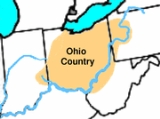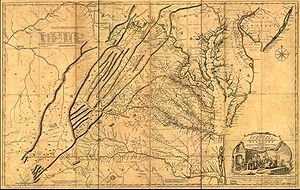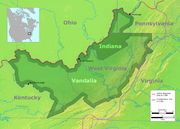
Ohio Company
Encyclopedia

Ohio Country
The Ohio Country was the name used in the 18th century for the regions of North America west of the Appalachian Mountains and in the region of the upper Ohio River south of Lake Erie...
(approximately the present state of Ohio) and to trade with the Indians there. The Company had a land grant from Britain and a treaty with Indians, but France also claimed the area, and the conflict helped provoke the outbreak of the French and Indian War
French and Indian War
The French and Indian War is the common American name for the war between Great Britain and France in North America from 1754 to 1763. In 1756, the war erupted into the world-wide conflict known as the Seven Years' War and thus came to be regarded as the North American theater of that war...
. No lands were actually settled, and the company ended operations by 1776.
Formation
In the mid 18th century, many within the British EmpireBritish Empire
The British Empire comprised the dominions, colonies, protectorates, mandates and other territories ruled or administered by the United Kingdom. It originated with the overseas colonies and trading posts established by England in the late 16th and early 17th centuries. At its height, it was the...
viewed the Ohio River Valley, a region west of the Appalachian Mountains
Appalachian Mountains
The Appalachian Mountains #Whether the stressed vowel is or ,#Whether the "ch" is pronounced as a fricative or an affricate , and#Whether the final vowel is the monophthong or the diphthong .), often called the Appalachians, are a system of mountains in eastern North America. The Appalachians...
thinly populated by American Indians
Native Americans in the United States
Native Americans in the United States are the indigenous peoples in North America within the boundaries of the present-day continental United States, parts of Alaska, and the island state of Hawaii. They are composed of numerous, distinct tribes, states, and ethnic groups, many of which survive as...
, as a source of potential wealth. In the 1740s, British and Irish businessmen such as George Croghan
George Croghan
George Croghan was an Irish-born Pennsylvania fur trader, Onondaga Council sachem, land speculator, British Indian agent in colonial America and, until accused of treason in 1777, Pittsburgh's president judge and Committee of Safety Chairman keeping the Ohio Indians neutral...
and William Trent were moving into the area and competing with French merchants in the lucrative fur trade
Fur trade
The fur trade is a worldwide industry dealing in the acquisition and sale of animal fur. Since the establishment of world market for in the early modern period furs of boreal, polar and cold temperate mammalian animals have been the most valued...
. Land speculators looked to the Ohio Country as a place where lands might be acquired and then resold to immigrants.

Virginia
The Commonwealth of Virginia , is a U.S. state on the Atlantic Coast of the Southern United States. Virginia is nicknamed the "Old Dominion" and sometimes the "Mother of Presidents" after the eight U.S. presidents born there...
ns, including Thomas Lee
Thomas Lee (Virginia colonist)
Thomas Lee was a leading political figure of colonial Virginia. He was a member of the Lee family, a political dynasty which included many figures from the pre-American Revolutionary War era until the late 20th century. Lee became involved in politics in 1710 and he became the resident manager of...
as president, Nathaniel Chapman as treasurer (1709–1760), John Mercer
John Mercer (colonial lawyer)
John Mercer was a colonial American lawyer, land speculator, and author.Born in Dublin, Ireland, he came to Virginia in 1720 where he built the colonial estate Marlborough...
as the company's secretary and general counsel, John's son George Mercer
George Mercer (military officer)
George Mercer was an American surveyor, military officer, and politician from Virginia....
as the company's agent to England, two of George Washington
George Washington
George Washington was the dominant military and political leader of the new United States of America from 1775 to 1799. He led the American victory over Great Britain in the American Revolutionary War as commander-in-chief of the Continental Army from 1775 to 1783, and presided over the writing of...
's brothers, Lawrence Washington
Lawrence Washington (1718-1752)
Lawrence Washington was a soldier and prominent landowner in colonial Virginia. As a founding member of the Ohio Company of Virginia, and a member of the colonial legislature representing Fairfax County, he was chiefly responsible for securing the establishment of the town of Alexandria, Virginia...
(who succeeded to the management upon the death of Lee) and Augustine Washington, Jr.
Augustine Washington, Jr.
Colonel Augustine Washington, Jr. was the second son of Augustine Washington and Jane Butler, and George Washington's half-brother. Augustine married Anne Aylett who was born in 1726 at "Nominy Plantation." According to the will of Augustine Washington Sr., the land now known as Mount Vernon...
, as well as Englishmen, including the Duke of Bedford
John Russell, 4th Duke of Bedford
John Russell, 4th Duke of Bedford KG, PC, FRS was an 18th century British statesman. He was the fourth son of Wriothesley Russell, 2nd Duke of Bedford, by his wife, Elizabeth, daughter and heiress of John Howland of Streatham, Surrey...
, Virginia Governor Robert Dinwiddie
Robert Dinwiddie
Robert Dinwiddie was a British colonial administrator who served as lieutenant governor of colonial Virginia from 1751 to 1758, first under Governor Willem Anne van Keppel, 2nd Earl of Albemarle, and then, from July 1756 to January 1758, as deputy for John Campbell, 4th Earl of Loudoun...
, and John Hanbury
John Hanbury
John Hanbury was one of a dynasty of ironmasters responsible for the industrialisation and urbanisation of the eastern valley through which runs the Afon Llwyd in Monmouthshire around Pontypool....
, a wealthy London merchant. A rival group of land speculators from Virginia, the Loyal Company, was organized about the same time, and included influential Virginians such as Thomas Walker
Thomas Walker (explorer)
Dr. Thomas Walker was a physician and explorer from Virginia who led an expedition to what is now the region beyond the Allegheny Mountains area of British North America in the mid-18th century...
and Peter Jefferson
Peter Jefferson
Peter Jefferson was the father of American President Thomas Jefferson . A surveyor and cartographer, his Fry-Jefferson Map of 1751 accurately depicted the Allegheny Mountains for the first time and showed the route of "The Great Road from the Yadkin River thro Virginia to Philadelphia distant 455...
(father of Thomas Jefferson
Thomas Jefferson
Thomas Jefferson was the principal author of the United States Declaration of Independence and the Statute of Virginia for Religious Freedom , the third President of the United States and founder of the University of Virginia...
).
In 1748, the British Crown approved the Ohio Company's petition for a grant of 200,000 acres (800 km²) near the "forks" of the Ohio River
Ohio River
The Ohio River is the largest tributary, by volume, of the Mississippi River. At the confluence, the Ohio is even bigger than the Mississippi and, thus, is hydrologically the main stream of the whole river system, including the Allegheny River further upstream...
(present Pittsburgh, Pennsylvania
Pittsburgh, Pennsylvania
Pittsburgh is the second-largest city in the US Commonwealth of Pennsylvania and the county seat of Allegheny County. Regionally, it anchors the largest urban area of Appalachia and the Ohio River Valley, and nationally, it is the 22nd-largest urban area in the United States...
). In July 1749, the governor and council of Virginia made the grant on the condition that the company would, within seven years, settle 100 families in the area and erect a fort to protect both them and the British claim on the land. A secondary purpose of this settlement was to establish a regular trade with the local Native Americans, necessary in order to maintain friendly relations. The organizers in 1752 signed a treaty of friendship and permission at Logstown
Logstown
The riverside village of Logstown was a significant Native American settlement in Western Pennsylvania and the site of the 1752 signing of the treaty of friendship between the Ohio Company and the Amerindians occupying the region in the years leading up to the...
with the main tribes in the region.
French and Indian War

In 1748-1750 the Ohio Company hired Thomas Cresap
Thomas Cresap
Colonel Thomas Cresap was an English-born pioneer settler in the state of Maryland, and an agent of Lord Baltimore in the Maryland-Pennsylvania boundary dispute. During the dispute, Cresap became a notorious figure in the Conejohela Flats areathe Susquehanna Valley in the area south of Wright's...
who'd opened a trading fort and founded Oldtown, Maryland
Oldtown, Maryland
Oldtown is an unincorporated community in Allegany County, Maryland along the North Branch Potomac River founded in 18th century colonial times. The settlement was initially called "Shawanese Old Town" because it was the site of a Shawnee Amerindian village abandoned about a decade earlier...
(now part of Cumberland
Cumberland, Maryland
Cumberland is a city in the far western, Appalachian portion of Maryland, United States. It is the county seat of Allegany County, and the primary city of the Cumberland, MD-WV Metropolitan Statistical Area. At the 2010 census, the city had a population of 20,859, and the metropolitan area had a...
) on the foot of the eastern climb up the Cumberland Narrows
Cumberland Narrows
The Cumberland Narrows is a water gap in western Maryland in the United States, just west of Cumberland, Maryland. Wills Creek cuts through the central ridge of the Wills Mountain Anticline at a low elevation here between Wills Mountain to the north and Haystack Mountain to the south...
along what was soon to be called the Nemacolin Trail, one of only three mid-mountain-range crossings of the Appalachian Ridge and Valley system
Ridge-and-valley Appalachians
The Ridge-and-Valley Appalachians, also called the Ridge and Valley Province or the Valley and Ridge Appalachians, are a physiographic province of the larger Appalachian division and are also a belt within the Appalachian Mountains extending from southeastern New York through northwestern New...
outside the Hudson-Great Lakes route, or southern Georgia-Mississippi-Western Tennessee plains route. Cresap was given a contract to blaze a mule trail over the mountains to the Monongahela River
Monongahela River
The Monongahela River is a river on the Allegheny Plateau in north-central West Virginia and southwestern Pennsylvania in the United States...
, and then to start widening this road into a wagon road.
In 1750, the Ohio Company hired Christopher Gist
Christopher Gist
Christopher Gist was an accomplished American explorer, surveyor and frontiersman. He was one of the first white explorers of the Ohio Country . He is credited with providing the first detailed description of the Ohio Country to Great Britain and her colonists...
, a skillful woodsman and surveyor, to explore the Ohio Valley in order to identify lands for potential settlement. He surveyed by estimating the Kanawhan Region and the Ohio Valley
Ohio River
The Ohio River is the largest tributary, by volume, of the Mississippi River. At the confluence, the Ohio is even bigger than the Mississippi and, thus, is hydrologically the main stream of the whole river system, including the Allegheny River further upstream...
tributaries beginning in 1750, 1751 and 1753. His journals provide valuable insights of the greater Ohio Valley and the Alleghenies
Allegheny Mountains
The Allegheny Mountain Range , also spelled Alleghany, Allegany and, informally, the Alleghenies, is part of the vast Appalachian Mountain Range of the eastern United States and Canada...
. Gist travelled as far west as the Miami Indian village of Pickawillany
Pickawillany
Pickawillany was a Miami Indian village located on the current site of the city of Piqua, Ohio, in the United States.It was created in 1748 by La Demoiselle, a Miami chief, and was destroyed by the French and their Indian allies under Charles Langlade in June 1752...
(near present Piqua, Ohio
Piqua, Ohio
Piqua is a city in Miami County, Ohio, United States. The population was 20,738 at the 2000 census. It is part of the Dayton Metropolitan Statistical Area.Piqua was one of the cities that experienced severe flooding during the Great Dayton Flood of 1913....
). Upon the basis of his report, the Ohio Company settled in an area in Western Pennsylvania
Western Pennsylvania
Western Pennsylvania consists of the western third of the state of Pennsylvania in the United States. Pittsburgh is the largest city in the region, with a metropolitan area population of about 2.4 million people, and serves as its economic and cultural center. Erie, Altoona, and Johnstown are its...
and present-day West Virginia
West Virginia
West Virginia is a state in the Appalachian and Southeastern regions of the United States, bordered by Virginia to the southeast, Kentucky to the southwest, Ohio to the northwest, Pennsylvania to the northeast and Maryland to the east...
; Gist and Cresap both receiving sizable settlements on the west side of the mountains. In 1752 the company had a pathway blazed between the small fortified posts at Wills Creek (Cumberland, Maryland
Cumberland, Maryland
Cumberland is a city in the far western, Appalachian portion of Maryland, United States. It is the county seat of Allegany County, and the primary city of the Cumberland, MD-WV Metropolitan Statistical Area. At the 2010 census, the city had a population of 20,859, and the metropolitan area had a...
), and at Redstone Old Fort
Redstone Old Fort
Redstone Old Fort or Redstone Fort or Fort Burd on The Nemacolin Trail was the name of the French and Indian War era wooden fort built in 1759 by Pennsylvania Militia Colonel James Burd to guard the ancient Indian trail's river ford on a mound overlooking the eastern shore of the Monongahela River...
(Brownsville, Pennsylvania
Brownsville, Pennsylvania
Brownsville is a borough in Fayette County, Pennsylvania, United States, officially founded in 1785 located 35 miles south of Pittsburgh along the Monongahela River...
) overlooking Redstone Creek
Redstone Creek
Redstone Creek is a historically important widemouthed canoe and river boat-navigable brook-sized tributary stream of the Monongahela River in Fayette County, Pennsylvania. The creek is long, running from headwaters on Chestnut Ridge north through the city of Uniontown and reaching the Monongahela...
and the Iroquois' ancient Monongahela
Monongahela River
The Monongahela River is a river on the Allegheny Plateau in north-central West Virginia and southwestern Pennsylvania in the United States...
River ford, which Cresap and Nemacolin had established in 1750.
The Ohio Valley was also claimed by France, however, as it was nominally part of the vast territory of New France
New France
New France was the area colonized by France in North America during a period beginning with the exploration of the Saint Lawrence River by Jacques Cartier in 1534 and ending with the cession of New France to Spain and Great Britain in 1763...
. The French feared the British settlements would cut off the links between Quebec and the Mississippi Valley. To forestall British expansion, in 1753 the French began constructing a series of forts in the Ohio Valley. Robert Dinwiddie
Robert Dinwiddie
Robert Dinwiddie was a British colonial administrator who served as lieutenant governor of colonial Virginia from 1751 to 1758, first under Governor Willem Anne van Keppel, 2nd Earl of Albemarle, and then, from July 1756 to January 1758, as deputy for John Campbell, 4th Earl of Loudoun...
, governor of Virginia as well as a shareholder of the Ohio Company, responded by sending a military unit under the command of George Washington to the region, which led to the outbreak of the French and Indian War
French and Indian War
The French and Indian War is the common American name for the war between Great Britain and France in North America from 1754 to 1763. In 1756, the war erupted into the world-wide conflict known as the Seven Years' War and thus came to be regarded as the North American theater of that war...
. The war and its sequel, Pontiac's Rebellion
Pontiac's Rebellion
Pontiac's War, Pontiac's Conspiracy, or Pontiac's Rebellion was a war that was launched in 1763 by a loose confederation of elements of Native American tribes primarily from the Great Lakes region, the Illinois Country, and Ohio Country who were dissatisfied with British postwar policies in the...
, prevented the Ohio Company from fulfilling its obligation to establish settlements.
Grand Ohio Company

Benjamin Franklin
Dr. Benjamin Franklin was one of the Founding Fathers of the United States. A noted polymath, Franklin was a leading author, printer, political theorist, politician, postmaster, scientist, musician, inventor, satirist, civic activist, statesman, and diplomat...
was interested. In 1772, the Grand Ohio Company received from the British government a grant of a large tract lying along the southern bank of the Ohio as far west as the mouth of the Scioto River. A colony to be called "Vandalia"
Vandalia (colony)
Vandalia was the name of a proposed British colony in North America . The colony was located south of the Ohio River, primarily in what is now the U.S...
was planned. However, the outbreak of the American Revolutionary War
American Revolutionary War
The American Revolutionary War , the American War of Independence, or simply the Revolutionary War, began as a war between the Kingdom of Great Britain and thirteen British colonies in North America, and ended in a global war between several European great powers.The war was the result of the...
interrupted colonization and nothing was accomplished. The company, based in London, ceased operations in 1776.
An entirely different "Ohio Company" was organized in 1786, composed largely of New England veterans who had certificates for land from Congress for their services during the Revolution.

